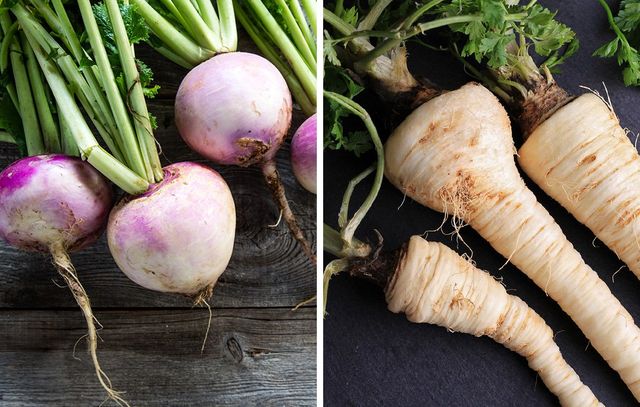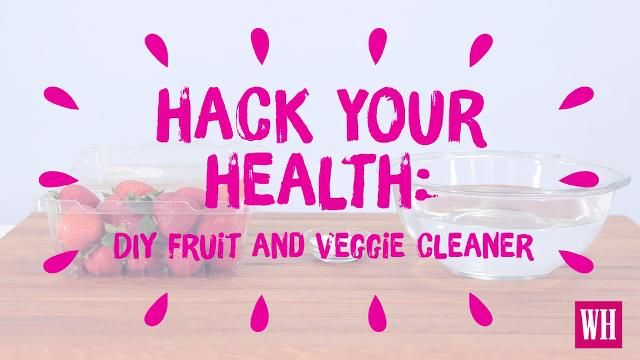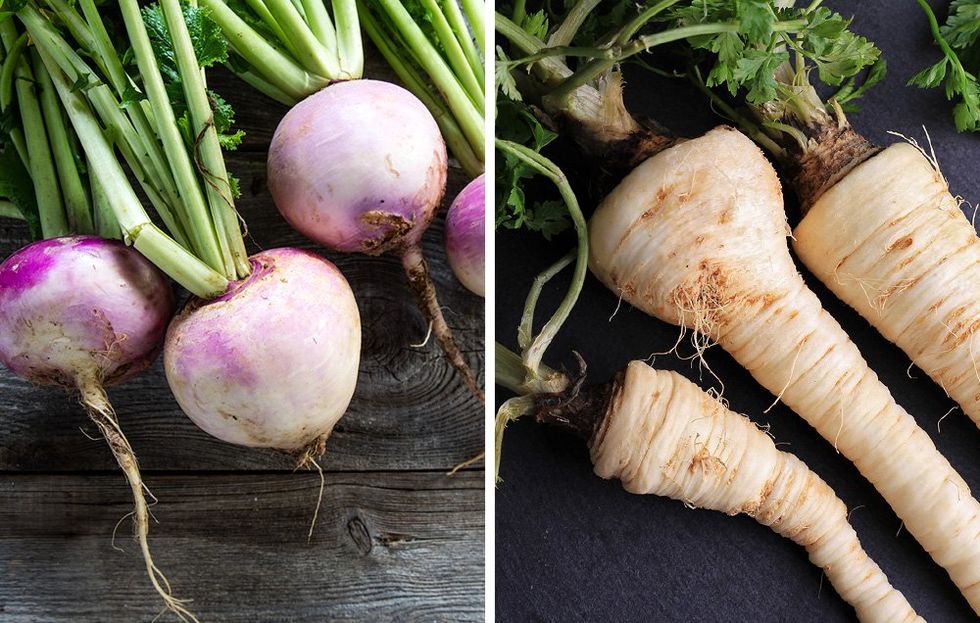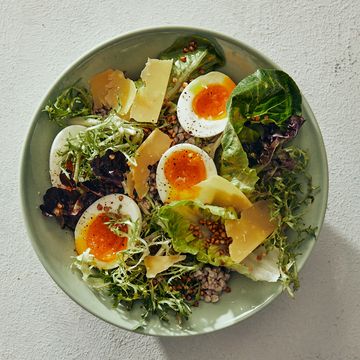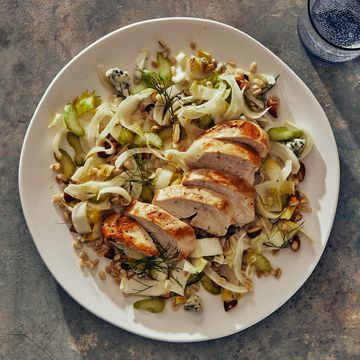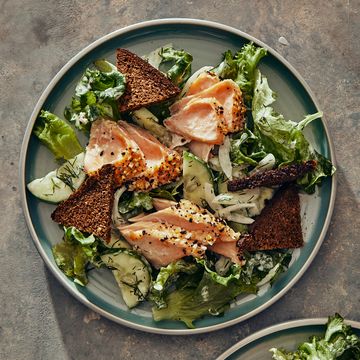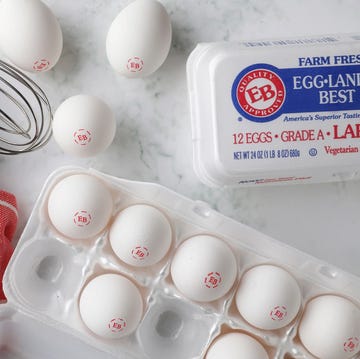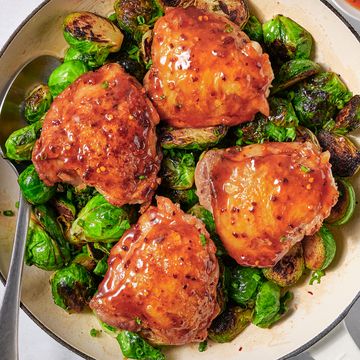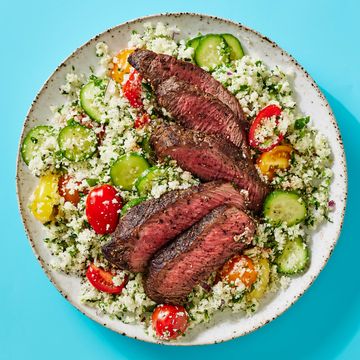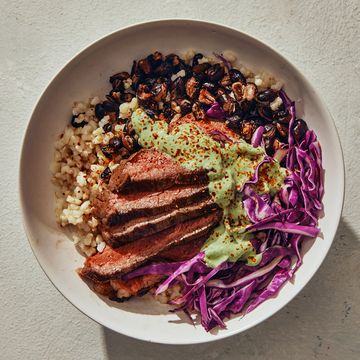At this point, we're all familiar with the most popular root vegetables: potatoes, sweet potatoes, onions, and carrots. But when was the last time you considered eating anything with parsnips or turnips? Due to their mild taste and unassuming appearance, we’ve unfairly resigned them to the backdrop of our winter cooking, when in reality, they deserve five-star treatment.
That's because parsnips and turnips are super-nutritious. These root vegetables boast high vitamin content (parsnips have lots of vitamin C, turnips have vitamin A), are relatively low-calorie, and are lower-carb alternatives to other root veggies like the aforementioned potatoes and sweet potatoes. (More on that later.)
If you're unfamiliar with these root vegetables, here's a quick primer. Turnips boast a pungent flavor similar to raw cabbage or radishes. Josh Axe, a clinical nutritionist and author of Eat Dirt: Why Leaky Gut May Be the Root Cause of Your Health Problems and 5 Surprising Steps to Cure It describes it as being similar to that of mustard greens, both offering a signature sharp, spicy flavor. Parsnips, on the other hand, have a nuttier, sweeter taste. “When included in any dish, parsnips add a distinct earthy richness and really up the flavor factor,” Axe says. (Hit the reset button—and burn fat like crazy with The Body Clock Diet!)
Both turnips and parsnips are in season during October, November, December, January, February and March, according to Kristin Kirkpatrick, R.D., and Lose It! advisor—making winter a good time to experiment with these nutritious root vegetables. Here's everything else you need to know about them:
How to pick parsnips and turnips at the grocery store
Parsnips and turnips should be heavy in weight for their size, according to Kirkpatrick. Avoid any with deep cuts, bruises, or visible signs of shriveling.
Related: Does It Really Matter What Kind Of Eggs You Buy?
How to store parsnips and turnips
Kirkpatrick says both turnips and parsnips thrive best in the crisper. However, parsnips stay longest wrapped in a damp cloth. Axe recommends wrapping turnips in a damp cloth, too, but says you should place them into an airtight container before popping them in the crisper drawer or near the bottom of the fridge.
Clean your produce with this DIY fruit & veggie cleaner:
How to prepare parsnips and turnips
In general, both turnips and parsnips should be washed and peeled before cooking. Give them a good scrub—as root vegetables, they pick up a lot of dirt! To cut cooking time, Kirkpatrick says to thinly peel both turnips and parsnips or cut them into uniform one-inch cubes.
Axe says you shouldn't toss the turnip greens, either. He recommends blanching them (boiling briefly then adding to cold water to preserve their color). This will help you avoid the bitter flavor generally associated with turnip greens, he says. “Most people prefer the taste of turnip greens when they are cooked and salted, since this helps to make them more mild and versatile in recipes,” he says.
Related: 4 Major Signs You're Eating Too Much Salt
How to cook with parsnips and turnips
Axe sweaters by thyme and dill flavors to complement both root vegetables. “Thyme has some mood-boosting qualities through the activity of carvacrol, one of its active compounds,” he says. He adds that preliminary research has shown consumption of thyme can also help ease coughing and bronchitis symptoms.
Dill offers a unique earthy and refreshing taste, but its health benefits alone are worth the try. “It’s another antioxidant-rich ingredient and has also been found, in various studies, to help with menstrual cramps, depression, heart health, epilepsy and bacterial infections,” he says.
Here are some other ideas on how to cook with these root veggies:
- Kirkpatrick uses parsnips in place of white potatoes. “We mash, roast, and use them in a vegan shepherd’s pie. The kids love it. They’re low in calories and high in fiber, which makes them a wonderful addition to our meals,” she says.
- Throw parsnips into soups, casseroles, and stews to add some body and nutrients. Axe recommends adding them during the last 30 minutes of cooking so they better retain their taste and texture.
- Grate parsnips and add them raw to salads.
- Approach cooking parsnips like you would carrots. You can eat them raw as part of a crudité platter, or bake, roast, boil, or steam them.
- Axe also likes to swap potatoes for parsnips in fries. Coat sliced parsnips with avocado oil, and sprinkle with rosemary, garlic cloves, pepper, and cumin. Bake at 450 F for 20 to 25 minutes, turning them about halfway through.
- Got kale and spinach fatigue? Use turnip greens the way you would for any salad or stir-fry base. Sauté the greens and add some garlic, lemon, olive oil, salt and pepper to unearth their taste.
Related: Is An Air Fryer Really Better For You Than A Regular Fryer?
What are some standout health benefits of turnips and parsnips?
As mentioned above, parsnips and turnips have fantastic nutritional benefits. Half a cup of sliced and boiled parsnip has 55 calories, 13 grams of carbohydrates, three grams of fiber, one gram of protein, and no fat. A half cup of cubed turnip has 17 calories, four grams of carbs, 1.6 grams of fiber, 0.5 grams of protein, and no fat. By comparison, an equivalent amount of baked Russet potatoes has 76 calories, 16 grams of carbohydrates, two grams of protein, 1.8 grams of fiber, and 0.1 grams of fat.
Because of its high vitamin C and folate content, Axe says consuming parsnips can help support long-term cardiovascular health. Expecting? Folate is also important for pregnant mothers and their developing babies to ward off neural tube birth defects, including cleft palate, spina bifida and brain damage. Their substantial manganese content can also help both enzyme production and bone health.
You might be gravitating towards the white starchy root of the turnip, but its the green leaves host most of its nutrients. According to one study, about 96 percent of the plant’s carotene (vitamin A) and about 84 percent of the B vitamins are stored within its leaf blades. “Turnip greens are also a great source of many other vitamins and minerals including vitamin K, vitamin C and calcium,” says Axe. “[They] contain roughly the same amounts of vitamin K and vitamin A as kale, one of my favorite superfoods, and about 10 times the amount of calcium than cauliflower.”
Their range of antioxidants is also impressive, says Axe, including one in particular that offers many disease-fighting benefits: glucosinolate, a large group of sulfur-containing glucoside molecules. It’s known for its cancer-fighting abilities because it facilitates healthy cell production and stimulates cell-death within cancerous human tumors.

